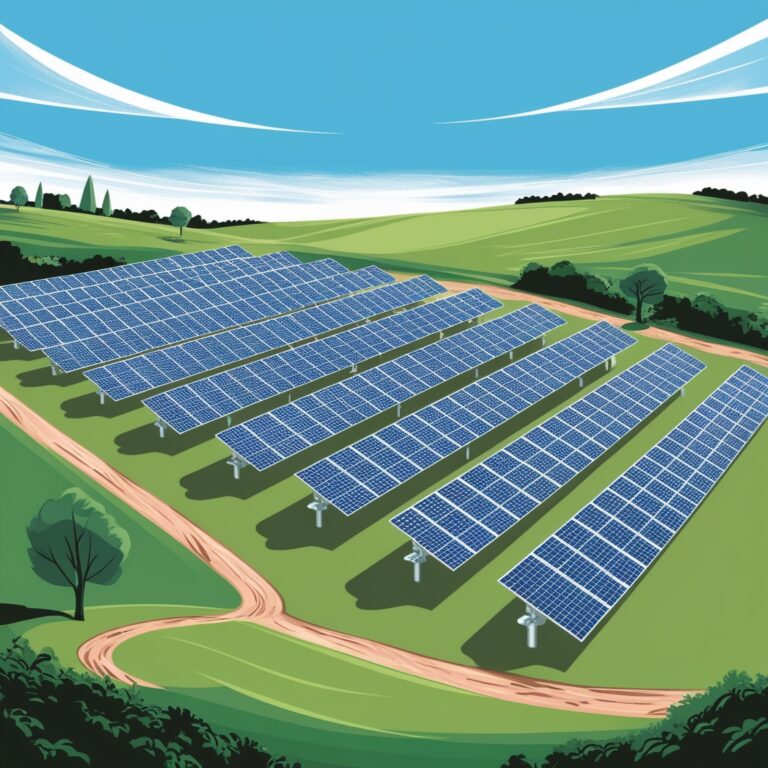Global Shift Towards Solar Energy: A Cheaper Alternative to Fossil Fuels and Nuclear Power
According to the International Renewable Energy Agency (IRENA), some countries now generate more than 80% of their new electricity capacity from renewable sources, with solar and wind energy accounting for 91% of this share.
In 2023, a record-breaking expansion in renewable energy deployment for electricity generation was achieved, bringing the global total capacity to 3,865 gigawatts (GW). Renewables contributed to 80% of newly added electricity capacity, with Asia leading the growth by accounting for 69% of this increase.
How Do Solar Energy Costs Compare to Other Energy Sources?
One of the most striking facts is that the cost of solar energy production dropped by an astonishing 90% between 2009 and 2020.
By 2020, the global average cost of electricity from large-scale solar power plants was just $0.037 per kilowatt-hour (kWh). In contrast, the cost of electricity from newly built coal power plants was three times higher at $0.112 per kWh, while natural gas stood at $0.059 per kWh, nuclear energy at $0.163 per kWh, and wind power at $0.04 per kWh.
With this significant reduction in costs—down to about four cents per kWh—the global cost of electricity generated from photovoltaic (PV) solar panels in 2023 was 56% lower than fossil fuel and nuclear alternatives. By 2024, the price of PV modules is expected to hit an all-time low.
What Is a Solar Tracker?
Solar power plants use solar trackers to adjust the angle of solar panels in alignment with the sun, maximizing electricity generation. Solar trackers can increase power output by 10% to 40%. Contrary to common belief, they are more widely used in regions with higher solar radiation. Over half of the large-scale solar power plants in the United States—especially in sun-rich areas—utilize this technology.
A solar tracker functions like a sunflower, moving throughout the day to ensure that solar panels are always oriented toward the sun’s rays. This allows the panels to capture the maximum amount of sunlight and generate more electricity, making the most efficient use of solar energy.
The global market for solar trackers is expanding rapidly, driven by the rising demand for clean energy and increased government support for renewable energy initiatives.
How Do Solar Panels Work with Solar Trackers?
In a fixed solar power system, the sun moves across the sky throughout the day, causing sunlight to hit solar panels at varying angles—known as the angle of incidence. The closer this angle is to 90 degrees, the higher the efficiency of the photovoltaic panels.
By integrating solar trackers, the panels continuously follow the sun’s movement, ensuring that sunlight always strikes the surface perpendicularly. This maximizes energy absorption and significantly boosts electricity production.
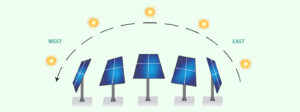
Sun Tracking Algorithm in Solar Trackers
Tracking Based on the Sun’s Position in the Sky
1. GPS-Based Solar Trackers
Solar trackers that rely on GPS data use precise positioning information as an advanced method for sun tracking. In this approach, software developers extract the solar movement algorithm for different times of the day and seasons. By entering the installation location of the system, the processor sends the necessary commands to the motor to adjust the solar panel to the optimal position relative to the sun.
2. Light Sensor-Based Tracking
Solar tracking systems use various optical sensors to track the sun’s position with high accuracy. These sensors, often photo-based, detect changes in sunlight direction and send movement commands to the motors, ensuring that the panels always remain at the best angle to capture maximum sunlight.
3. Hybrid Tracking (GPS + Light Sensors)
In modern tracking systems, sun movement algorithms primarily determine panel positioning, while light sensors serve as a backup. If the sky becomes cloudy, the light sensor adjusts the panel angle based on the sun’s optimal position. This setup also enables the implementation of backtracking in these systems.
Backtracking in Solar Power Plants: A Strategy for Higher Efficiency
What is Backtracking?
Backtracking is a smart tracking technique used in solar power plants to optimize energy production and reduce shading between rows of solar panels.
Why is Backtracking Important?
In single-axis tracking systems, solar panels rotate throughout the day to maximize sunlight exposure. However, in early morning and late afternoon, the sun’s angle may cause shadows from one row of panels to fall onto adjacent rows, significantly reducing energy efficiency.
With backtracking, panel angles are intelligently adjusted to prevent shading. Instead of always directly facing the sun, the system slightly modifies the panel angles to minimize shading effects. Although some panels may deviate from the ideal sun-facing position, overall energy production in the power plant increases.
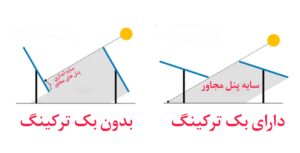
Difference Between Types of Solar Trackers in Photovoltaic Power Plants (Solar Panels) Based on Mechanism: Fixed, Single-Axis, and Dual-Axis
Fixed Solar Panels
In fixed-type solar power plants, the panels are usually positioned facing south with an inclination angle of 20 to 30 degrees relative to the horizon.
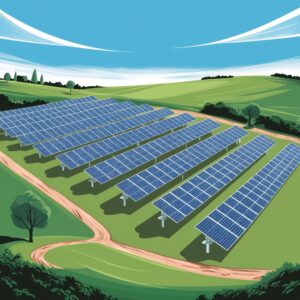
“Single-axis solar panels
In single-axis tracking systems (Single Axis Tracker), there is typically one axis of rotation that moves the panels from east to west. The axis of rotation is aligned from north to south, allowing the solar panels to tilt towards the east at sunrise and towards the west at sunset. This way, by moving the panels in the direction of the sun, the solar panels are always positioned at the optimal angle relative to the sun from dawn to dusk. A single-axis tracker can increase the electricity production efficiency of a solar power plant by 15 to 25 percent on average. Novin Ofogh Company, leveraging the technical expertise of its specialists, has designed and manufactured the single-axis tracker system for photovoltaic power plants.”

“Dual-axis solar panels:
Dual-axis solar tracking systems, utilizing two independent axes of rotation, are capable of adjusting the solar panels to face the sun at all times. The first axis controls the east-to-west movement of the panels, while the second axis adjusts the angle of the panels based on the sun’s elevation. These systems typically consist of electric motors, gearboxes, optical sensors or GPS-based solar trackers, and an intelligent control system. A dual-axis tracker can increase the energy output of a solar power plant by 20 to 40 percent.
Novin Ofogh Company, leveraging the technical expertise of its specialists, has designed and manufactured the dual-axis tracking system for photovoltaic power plants.”
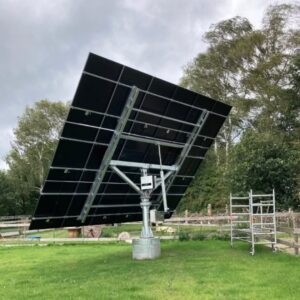
“Costs of installing solar trackers:
According to available data, installing single-axis trackers increases the capital investment in a solar power plant by 10 to 20 percent, while in dual-axis tracker systems, the increase in initial capital investment reaches 20 to 30 percent.
Therefore, the choice between fixed structures, single-axis, and dual-axis trackers should be made based on the budget, available space, and operational goals.”

“Increase in efficiency with solar trackers
To compare efficiency, the output of an optimized single-axis tracking system can be compared with a fixed system (both with a 10 kW peak capacity) on a single day.”
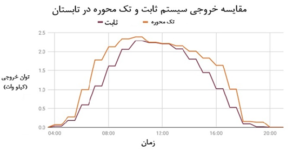
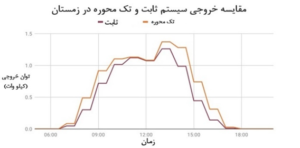
“Difference in efficiency of fixed, single-axis, and dual-axis photovoltaic panels in different seasons
To better understand the difference in efficiency, we can compare the output of three different systems (fixed, single-axis, and dual-axis) in each season:”
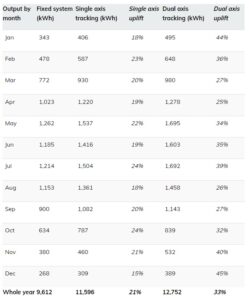
“These differences show that solar tracking systems, especially dual-axis systems, can significantly increase energy efficiency compared to fixed systems.
Single-axis and dual-axis systems perform more efficiently than fixed systems in all seasons. However, this efficiency gap reaches its maximum during the spring and summer due to increased sunlight and the optimal angle of the panels.
Some important advantages of single-axis solar power plants:
Limited space: If you do not have enough space to install fixed solar panels, single-axis trackers can generate more electricity with the same number of panels.
High output during morning and evening hours: Single-axis trackers can increase electricity output during these hours when the demand for power is higher.
Commercial applications: Solar trackers are beneficial for commercial projects that seek maximum energy yield from their solar system, improving panel efficiency.
Conclusion:
The growing trend of solar energy use, particularly with the adoption of advanced technologies such as solar trackers, has brought a significant transformation in clean energy production and reduced reliance on fossil fuels. The sharp decline in production costs and increased panel efficiency has made solar energy more accessible to individuals and communities. These advancements not only help reduce greenhouse gas emissions and combat climate change, but also create new economic opportunities.
The use of single-axis and dual-axis solar tracking systems dramatically increases the energy efficiency of solar panels. Although they have higher initial costs compared to fixed systems, the increased energy production and the need for renewable energy make this additional cost justifiable.
Overall, the future of solar energy is very bright, and this technology will play a central role in building a more sustainable and greener world.
Sources:“
2- www.dw.com
3-
A- The IOSR Journal of Electrical and Electronics Engineeringَ discusses the design and construction of cost-effective solar trackers.
B- An article on PV-Tech provides an international overview of bifacial PV tracking systems and their financial implications.
4- www.spiritenergy.co.uk

